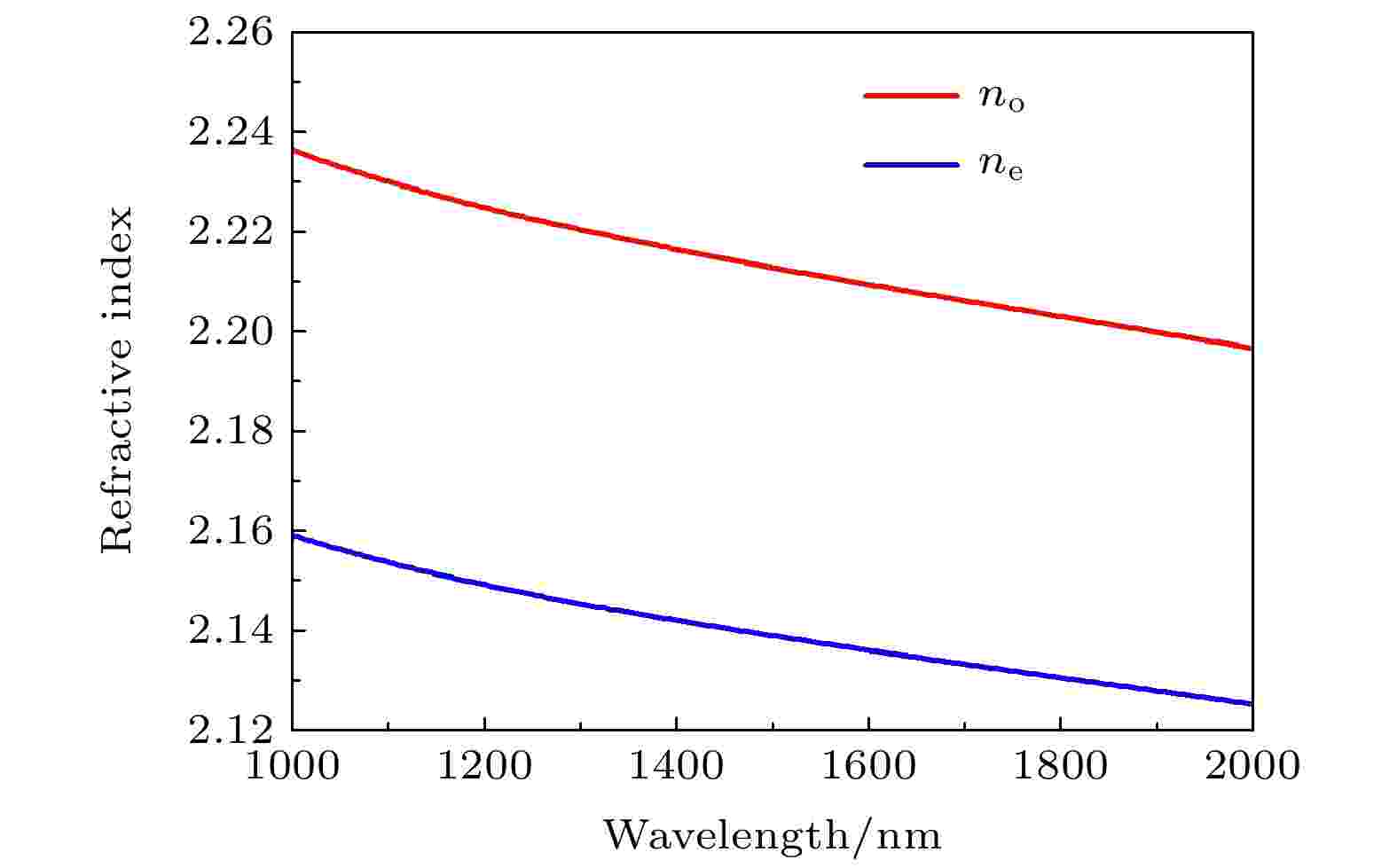全文HTML
--> --> -->但从实际应用角度考虑, 光学频率梳目前还面临着一些挑战. 1) 国际单位制量子化变革带来计量方法和量值传递技术的扁平化、嵌入式, 使得对光学频率梳的微型化需求迫切, 从而催生和带动了芯片光梳技术的发展. 但芯片光梳在技术指标上与传统飞秒光学频率梳还存在一定差距. 2) 光学频率梳应用于激光频率测量时, 光学频率梳输出激光与待测激光高信噪比的拍频信号获取一直是个瓶颈. 这需要从物理机制和光纤设计上抑制激光频率转换过程中引入的额外噪声, 使光学频率梳的光谱保持良好的相干性. 3) 可见光到近红外波段光学频率梳的研究趋于成熟, 但位于分子特征谱线、大气透明窗口的中红外波段自参考飞秒光学频率梳还面临一系列挑战, 包括中红外波段扩谱光纤的制备与器件集成、光谱调控和相干性控制等. 4) 在光钟研究中, 为了实现光钟的比对测量, 如何使覆盖多种光钟钟激光波长的宽光谱光学频率梳的梳齿都具有超窄线宽特性也是当前光学频率梳研究中的重要方向之一. 通常的掺Er光纤光梳, 由于受增益介质上能级寿命的影响, 其梳齿线宽一般在百kHz量级. 在光钟信号转换过程中, 不可避免地会对高准确度和高稳定度的信号造成损失, 而通过对光梳梳齿线宽的压窄则可以很好地解决这一问题[10-13].
窄线宽光纤光梳的关键在于高品质的飞秒激光器. 在光纤光梳中飞秒激光器重复频率(fr)通常由腔内压电陶瓷(piezoelectric transducer, PZT)控制, 载波包络偏移频率(f0)通常由飞秒激光器的驱动电流源控制. 受伺服机构自身特性影响, PZT和电流源的伺服带宽都在几十kHz或者更低. 这导致在光纤光梳的锁定过程中, 激光器中的高频噪声无法得到抑制.
一种有效方法是在激光器中增加快速响应的电光调制器(electro-optic modulator, EOM). 电光调制器在激光器系统中主要作为宽带伺服的反馈器件具有伺服带宽宽的优点, 但伺服范围较小, 因此通常要与伺服范围大的器件配合使用. 2005年, 美国Hudson等[14]采用在掺Er光纤飞秒激光器中加入空间EOM的方法, 实现了大于230 kHz的伺服带宽. 2010年, 日本Nakajima等[10]采用在激光器腔内加入空间EOM的方法也获得了大于200 kHz的伺服带宽, 后来该研究组改用波导型带尾纤的EOM, 伺服带宽可以达到1.3 MHz[15]. 波导型EOM需要的驱动电压较低并且可以灵活插入腔内, 但波导型EOM输入和输出尾纤需要与激光器腔内光纤连接, 因此插入损耗较大, 不利于在高重复频率激光器中使用. 2017年Torcheboeuf等[16]在Er/Yb玻璃作为增益介质的固体激光器中采用EOM实现了激光器向参考激光的锁定, 锁定带宽为700 kHz, 其中EOM的引入对激光器中心波长、功率和脉冲宽度都带来很大的影响. 2018年德国Schweyer等[17]采用在半导体可饱和吸收镜锁模的光纤激光器中加入了EOM, 通过EOM结合激光器温度控制, 实现了光梳向633 nm氦氖激光器超过46小时的连续锁定, 锁定带宽610 kHz.
我国光学频率梳技术已经取得了快速发展, 国内许多单位都已开展了光学频率梳的研究, 如钛宝石光梳、掺Er光纤光梳、掺Yb光纤光梳和掺Tm光纤光梳等等. 在光谱范围、重复频率、输出功率、稳定性和可靠性等指标上都有了显著的提升. 在基于EOM的光纤光梳方面, Ning等[18]在全保偏多路输出的光纤光梳中增加了EOM, 并可以采用EOM结合PZT的方式进行重复频率锁定. Ma等[19]在掺Yb光纤光梳中增加了EOM, 实现了0.95 GHz的高重复频率输出以及和6束不同波长激光的拍频信号探测, 但EOM在该光梳中快速锁定效果没有验证. Wang等[20]在掺Yb光纤光梳中增加了EOM, 利用EOM将光纤光梳锁定在972 nm窄线宽激光上, 验证了EOM锁定带宽320 kHz. 但在窄线宽光学频率梳, 特别是基于目前常用的掺Er光纤光梳的窄线宽光学频率梳的研究还有进一步提升的空间.
基于此, 本文主要研究了掺Er光纤飞秒激光器中铌酸锂(LiNbO3, LN)电光晶体对激光器参数的影响. 通过计算LN晶体的折射率、色散和相位延迟等参数, 分析了LN晶体对激光器参数的影响, 并在实验上获得了LN晶体电压对激光器重复频率和载波包络偏移频率的影响, 进而通过LN晶体实现了对光纤光梳重复频率和载波包络偏移频率的锁定. 通过锁定光纤飞秒激光器与窄线宽激光器的拍频信号, 验证了LN晶体的引入使激光器的伺服锁定带宽提高到了236 kHz, 为窄线宽飞秒光学频率梳的建立提供了技术基础.
2.1.LN晶体的线性电光效应
系统中选择LN晶体作为EOM中的电光晶体. LN晶体属于单轴晶体, 晶体的光轴为z轴, 垂直光轴的两个轴分别为x轴和y轴. no和ne是寻常光和非寻常光的主折射率. 在不加电场时LN晶体的折射率椭球可以表示为

在外加电场作用下, LN晶体的折射率椭球表示为
2
2.2.LN晶体对掺Er光纤飞秒激光器的影响
32.2.1.LN晶体对重复频率的影响
在掺Er光纤飞秒激光器中LN晶体对重复频率的调节, 主要通过晶体加电压后对折射率产生影响来实现. 其对重复频率的调节范围直接受晶体的折射率变化率的影响, 即LN晶体加电压后的折射率
首先需要知道LN晶体中o光和e光的折射率曲线. LN晶体的折射率曲线可通过Sellmeier色散方程进行计算, 其中o光和e光在波长λ处折射率表示为
 图 1 LN晶体的折射率曲线
图 1 LN晶体的折射率曲线Figure1. Refractive index curves of LiNbO3 crystal.
加电压后, LN晶体折射率的相对变化量为
3
2.2.2.LN晶体对腔内色散的影响
LN晶体作为色散介质放于激光器腔内, 由于晶体入射面和出射面镀增透膜, 因此插入损耗可以忽略不计, 但晶体色散对激光器影响很大. 根据晶体折射率公式, 可以得出LN晶体的群速度色散曲线, 如图2所示. 图 2 LN晶体的群速度色散曲线
图 2 LN晶体的群速度色散曲线Figure2. Group velocity dispersion curves of LiNbO3 crystal.
实验中采用的LN晶体在1550 nm处的群速度色散(group velocity dispersion, GVD)为112 fs2/mm. 为了平衡LN晶体在腔内引入的正色散, 需要利用五倍晶体长的SMF-28单模光纤进行色散补偿(SMF-28单模光纤在1550 nm处的群速度色散为–22 fs2/mm). 在线性电光效应下, 晶体加电场后产生的折射率是随电场强度的线性变化, 因此加电场前后, 可以忽略电场对LN晶体色散带来的影响.
3
2.2.3.LN晶体引入的相位延迟
LN晶体在外加电场作用下, 入射到晶体的光的偏振方向会沿着晶体感应折射率主轴分解成两个相互垂直的偏振分量传输. 两个偏振方向的光所经历的折射率分别发生不同的改变, 从而产生不同的相位延迟, 从晶体出射后合成新的偏振态. 而非线性偏振旋转锁模的原理是通过控制腔内激光不同分量的偏振状态实现锁模, 所以LN晶体在外加电场作用下引入的相位延迟会对激光器锁模带来影响.由于LN晶体z轴加电压时具有高于其他轴加电压的一次电光效应, 因此实验中采用激光沿x轴通过晶体. 此时, 沿y轴和z轴两个偏振方向上的折射率变化由之前的公式给出. 激光通过长度为L的晶体后, 产生的相位差δ为
 图 3 腔内加入EOM的掺Er光纤光梳结构图. 其中, LD为激光二极管, WDM为980 nm/1550 nm波分复用器件, EDF为增益光纤, Col为光纤准直器, PBS为偏振分光片, ISO为隔离器, λ/4为四分之一波片, λ/2为二分之一波片, M为平面反射镜, PZT为压电陶瓷, EOM为电光晶体调制器, HNLF为高非线性光纤, F为透镜, PD为光电探测器, PPL为伺服锁定环路, PPLN为周期极化LN晶体, SW为微波线切换模块
图 3 腔内加入EOM的掺Er光纤光梳结构图. 其中, LD为激光二极管, WDM为980 nm/1550 nm波分复用器件, EDF为增益光纤, Col为光纤准直器, PBS为偏振分光片, ISO为隔离器, λ/4为四分之一波片, λ/2为二分之一波片, M为平面反射镜, PZT为压电陶瓷, EOM为电光晶体调制器, HNLF为高非线性光纤, F为透镜, PD为光电探测器, PPL为伺服锁定环路, PPLN为周期极化LN晶体, SW为微波线切换模块Figure3. Schematic diagram of the Er-fiber comb with an intra-cavity EOM. LD, laser diode; WDM, 980 nm/1550 nm wavelength division multiplexing; EDF, Er-doped gain fiber; Col, fiber collimator; PBS, polarization beam splitter; ISO, isolator; λ/4, quarter wave plate; λ/2, half wave plate; M, plane mirror; PZT, piezoelectric transducer; EOM, electro-optic modulator; HNLF, highly nonlinear fiber; F, optical lens; PD, photoelectric diode; PPL, phase lock loop; PPLN, Periodically Poled Lithium Niobate; SW, signal switch module
1)飞秒激光器中增加了LN晶体构成的EOM. 在激光器的四分之一波片和PBS之间增加一个LN晶体. LN晶体的通光截面(yz)为3 mm × 5 mm, 通光长度(x)为3 mm, xz表面镀金用于施加电压. 采用最大200 V的EOM驱动器(Thorlabs, HVA200)对LN晶体施加电压;
2) f0探测模块进行了改进. f-2f干涉仪中晶体前后两端的透镜进行了集成设计和封装, 形成了一体化模块. 其中输入端为FC/PAC接口, 输出端为平行光输出. 采用该模块, HNLF后单模光纤的FC/PAC接口可以直接与f0探测模块连接, 避免了优化HNLF后单模光纤长度时, 每次都需要对f0探测模块进行调节的弊端;
3)四个伺服锁定环路. 伺服锁定环路PPL1由伺服模块(Vescent, D2-135)控制飞秒激光器的抽运电流源(Thorlabs, LDC8020)构成, 伺服锁定环路PPL2由伺服模块(Vescent, D2-135)控制EOM的驱动器构成. 伺服锁定环路PPL1和伺服锁定环路PPL2可分别控制激光器的载波包络偏移频率f0. 伺服锁定环路PPL3由伺服模块 (Vescent, D2-125)控制EOM的驱动器构成, 伺服锁定环路PPL4由伺服系统(Vescent, D2-125)控 制PZT驱动器(Thorlabs, MDT694B)构成. 伺服锁定环路PPL3和伺服锁定环路PPL4可分别控制激光器的重复频率fr.
4.1.激光器状态
激光器腔内不加EOM时, 激光器的整体结构与文献[21]类似. 激光器中增益光纤长度为35 cm, WDM两端尾纤长度分别为15和12 cm, 两个准直器的尾纤长度分别为20和37 cm. 两个准直器之间的空间距离为5.5 cm. 在650 mW抽运功率下, 激光器在连续光状态下可以输出150 mW, 锁模后平均功率为85 mW. 此时加入EOM, 调节LN晶体放置角度, 使腔内激光垂直入射到LN晶体表面, 激光器输出功率保持不变. 在最佳锁模状态下, EOM的放入或者取出对激光器的自动启动锁模没有影响. 图4给出了激光器腔内有无EOM时的锁模光谱. 从图中可以看出, EOM的引入对激光器锁模影响不大. 这主要源于EOM中LN晶体通光长度较短, 对激光器的色散影响可以忽略不计. 图 4 激光器腔内有无EOM时的锁模光谱
图 4 激光器腔内有无EOM时的锁模光谱Figure4. Spectra of the Er-fiber femtosecond laser with and without an intra-cavity EOM.
激光器输出激光经过1∶3的光纤分束器分成三路, 第一路直接进入探测器PD(EOT, 3000 A)用于探测激光器重复频率fr. 图5为激光器中加入EOM锁模后的射频曲线. 从图5中可以看出激光器重复频率为163 MHz. 第二路通过后续放大、扩谱、f-2f干涉仪, 实现40 dB信噪比的f0信号输出, 如图6所示. 图6插图为HNLF扩谱后的倍频程光谱, 光谱覆盖1100到2200 nm. 第三路在本系统中用于与1542 nm窄线宽激光器拍频获取拍频信号fb.
 图 5 激光器中加入EOM锁模后的射频曲线, 其中插图为163 MHz处的频谱
图 5 激光器中加入EOM锁模后的射频曲线, 其中插图为163 MHz处的频谱Figure5. Radio frequency of the Er-fiber femtosecond laser with an intra-cavity EOM. The insert is the radio frequency at 163 MHz.
 图 6 激光器载波包络偏移频率, 插图为扩谱后的倍频程光谱图
图 6 激光器载波包络偏移频率, 插图为扩谱后的倍频程光谱图Figure6. Signal-to-noise ratio of carrier-envelop offset frequency in 100 kHz resolution bandwidth (RBW). The insert is octave spanning spectrum after HNLF.
EOM中LN晶体施加电压后, 对激光器重复频率和f0信号会产生影响, 因此EOM可以作为伺服器件用于对激光器重复频率和f0的锁定. 当EOM晶体上的电压在–200到200 V之间变化时, 激光器重复频率的变化量约为30 Hz, 如图7(a)所示. 激光器重复频率变化主要是由于EOM中晶体施加电压后引起折射率变化所致. 在激光器重复频率漂移量较小的条件下, 可以利用EOM对激光器重复频率进行锁定. 当EOM晶体上的电压从–200到200 V逐渐增大时, 激光器f0信号的变化量约为25 MHz, 如图7(b)所示. 在电压调节过程中f0信噪比保持不变.
 图 7 EOM晶体电压对激光器参数的影响 (a) EOM晶体电压对激光器重复频率的影响; (b) EOM晶体电压对激光器载波包络偏移频率的影响
图 7 EOM晶体电压对激光器参数的影响 (a) EOM晶体电压对激光器重复频率的影响; (b) EOM晶体电压对激光器载波包络偏移频率的影响Figure7. Diagram showing the change in laser parameters at different voltage on EOM: (a) The change in repetition rate; (b) the change in carrier envelope offset frequency.
 图 8 EOM晶体电压改变时, 激光器输出光谱变化
图 8 EOM晶体电压改变时, 激光器输出光谱变化Figure8. Evolution of the spectra of the Er-fiber femtosecond laser with the changing of the voltage on EOM.
EOM中晶体施加电压后, 在对激光器重复频率和f0信号产生影响的同时, 要避免对激光的锁模状态产生影响. 在系统优化过程中通过微调LN晶体, 使晶体电压在–200到200 V之间变化时, 激光器保持相同的锁模状态. 图8给出了激光器腔内EOM晶体电压改变时, 激光器输出光谱的变化. 从图8中可以看出, 本系统中EOM在不同驱动电压下, 激光器锁模光谱未发生明显变化.
2
4.2.激光器向微波频率的锁定
在锁定系统中增加EOM驱动器(Thorlabs, HVA200), 其输出电压直接作用于EOM中的LN晶体. 伺服锁定环路PPL2由伺服模块(Vescent, D2-135)控制EOM驱动器构成. f0信号与参考信号鉴相输出信号通过微波线切换模块, 可选取进入PPL1或者PPL2环路, 控制激光器的载波包络偏移频率f0信号.伺服锁定环路PPL3由伺服模块(Vescent, D2-125)控制EOM驱动器(Thorlabs, HVA200)构成. fr信号与参考信号混频输出信号通过微波线切换模块, 可选取进入PPL3环路或者PPL4环路, 控制激光器的重复频率fr信号. 由于激光器腔内只有一个EOM并且EOM驱动器的输入端为单通道输入, 所以工作时伺服锁定环路PPL2和伺服锁定环路PPL3只有一路接入EOM的输入端.
本系统可以分别通过以下方式实现对激光器f0和fr信号的锁定:
1)伺服锁定环路PPL1和伺服锁定环路PPL4同时使用, 即伺服锁定环路PPL1通过控制抽运激光器电流源实现对f0的锁定, 伺服锁定环路PPL4通过控制PZT驱动器实现对fr的锁定;
2)伺服锁定环路PPL1和伺服锁定环路PPL3同时使用, 即伺服锁定环路PPL1通过控制抽运激光器电流源实现对f0的锁定, 伺服锁定环路PPL3通过控制EOM驱动器实现对fr的锁定;
3)伺服锁定环路PPL2和伺服锁定环路PPL4同时使用, 即伺服锁定环路PPL2通过控制EOM驱动器实现对f0的锁定, 伺服锁定环路PPL4通过控制PZT驱动器实现对fr的锁定.
伺服锁定环路PPL1和伺服锁定环路PPL4的锁定方法在许多文献中都有介绍[22-24]. 本文主要关注通过伺服锁定环路PPL2和伺服锁定环路PPL3实现向微波频率的锁定.
重复频率fr的锁定主要通过控制激光器的腔长实现. 在本系统中, 一种方式是可以通过PZT实现重复频率的锁定. 该方法的特点是控制范围较大(kHz量级), 可以实现长时间连续锁定. 另一种方式是通过EOM实现对重复频率的锁定. 该方法的特点是控制范围较小(Hz量级), 但可以实现光梳高频噪声的抑制. 特别是以光学频率作为参考时, 采用EOM可以实现飞秒激光器梳齿线宽的压窄.
以微波频率作为参考进行光梳重复频率锁定时, 重复频率与参考频率混频输出的误差信号进入伺服锁定环路PPL3. PPL3环路中的伺服模块控制EOM驱动器输出的电压直接作用到EOM, 通过改变EOM中LN晶体的折射率实现激光器重复频率的锁定. 系统中采用光电探测器PD获得激光重复频率的一次谐波. 调节频率综合器使其输出频率位于重复频率一次谐波附近, 即163623966.432 Hz. 在自由运转的条件下, 激光器在50 h间内重复频率漂移量在600 Hz左右, 如图9所示. 而EOM中LN晶体在 ± 200 V的条件下, 对重复频率的调节量只有60 Hz. 因此采用EOM实现对重复频率的锁定时间较短. 图10(a)给出了3 h的锁定时间内激光器重复频率的平均值和标准差. 重复频率锁定后的平均值为163623966.43216 Hz, 标准差为0.474 mHz.
 图 9 激光器自由运转时, 重复频率漂移
图 9 激光器自由运转时, 重复频率漂移Figure9. Frequency drift of the repetition rate.
 图 10 重复频率锁定后的频率变化 (a) 采用EOM锁定重复频率; (b) 采用PZT锁定重复频率
图 10 重复频率锁定后的频率变化 (a) 采用EOM锁定重复频率; (b) 采用PZT锁定重复频率Figure10. Residual fluctuations of the repetition rate when it is phase-locked: (a) Phase-locked by EOM; (b) phase-locked by PZT.
为了对比, 重复频率与参考频率混频输出的误差信号通过微波线切换模块切换进入伺服锁定环路PPL4. 由于激光器重复频率漂移, 因此调节频率综合器使其输出频率位于163623411.431 Hz附近, 以匹配此时的重复频率. 其中PPL4中伺服模块控制PZT驱动器输出电压直接作用到PZT上, 通过改变PZT伸缩量实现激光器重复频率的锁定. 图10(b)给出了7.5 h的锁定时间内激光器重复频率的平均值和标准差. 重复频率锁定后的平均值为163623411.43121 Hz, 标准差为0.473 mHz.
图11给出了为分别采用EOM和PZT锁定重复频率时所获得的相对Allan偏差曲线. 在平均时间0—1000 s内, 两种锁定方法得到的相对Allan偏差基本一致. 因此, 当重复频率不需要长时间锁定时, 可以在飞秒激光器中直接加入EOM以简化重复频率锁定时飞秒激光的复杂性. 而先前无论是PZT控制端镜还是PZT拉伸光纤[14,21,25], 都需要在激光器建立过程中把伺服器件加入激光腔内. 后续采用EOM结合与对激光器底板温度控制相结合的方式有望实现激光器重复频率的长时间连续锁定.
 图 11 采用EOM和PZT锁定重复频率后, 所获得的重复频率的相对Allan偏差曲线
图 11 采用EOM和PZT锁定重复频率后, 所获得的重复频率的相对Allan偏差曲线Figure11. Calculated Allan deviations when the repetition rate was phase-locked by EOM and PZT respectively.
以微波频率作参考进行光梳的f0信号锁定时, f0信号与参考频率鉴相输出的误差信号进入伺服锁定环路PPL2. 其中伺服模块的输出控制EOM驱动器输出的电压直接作用到EOM, 通过改变EOM中LN晶体的折射率实现f0信号的锁定. 激光器在自由运转的条件下, 载波包络偏移频率f0信号在16 h内的漂移量在20 MHz左右, 如图12所示. 而EOM在 ± 200 V的条件下, 对载波包络偏移频率的调节量可以达到25 MHz, 足以满足对载波包络偏移频率的控制. 图13给出了18 h的锁定时间内激光器f0信号的平均值和标准差. f0信号锁定后平均值为20 MHz, 标准差为1.03 mHz.
 图 12 自由运转时f0信号漂移曲线
图 12 自由运转时f0信号漂移曲线Figure12. Frequency drift of the carrier envelope offset frequency.
 图 13 采用EOM锁定f0信号后的频率变化
图 13 采用EOM锁定f0信号后的频率变化Figure13. Residual fluctuations of the carrier envelope offset frequency when it is phase-locked by EOM.
2
4.3.EOM中LN晶体伺服带宽的测量
激光器中增加快速响应的LN晶体, 主要为了提高光梳的伺服带宽、抑制光纤光梳中高频噪声, 为光纤光梳向窄线宽激光器的锁定提供伺服器件. 在光梳fr和f0两个参数向微波锁定的过程中, LN晶体的快环特性不是必须的. 但当光梳梳齿线宽压窄时, 光梳的锁定带宽必须得到提高才能抑制高频噪声. 为了验证EOM引入对激光器的伺服锁定带宽的改善, 采用将飞秒激光器锁定于一台超窄线宽激光器, 通过测量锁相环内拍频信号边带宽度来判断伺服锁定带宽.采用锁定到高Q腔的波长为1542 nm的窄线宽激光器作为参考光源, 激光器秒稳定度1.5 × 10–15, 线宽小于2 Hz, 输出功率大于10 mW. 采用20 m单模保偏光纤将激光传输至飞秒激光器所在的光学台面进行拍频. 飞秒激光器输出激光经过1:3的光纤分束器分成三路后的第三路光约5 mW进入拍频模块. 经仔细调节两路光空间耦合、偏振、聚焦、光斑等参数, 在100 kHz分辨率带宽和40 MHz频带范围内, 可以获得大于40 dB信噪比的拍频信号fb.
拍频信号fb与20 MHz微波参考信号混频, 误差信号进入锁定模块(Vescent, D2-125), 其输出信号通过PZT驱动器反馈控制PZT. D2-125附加输出信号进入锁定模块(New Focus, LB1005), 通过EOM驱动器反馈控制LN晶体实现fb的快环锁定. 当只有PZT锁定时, 环内拍频信号如图14(a)所示. 从图14(a)中可以看出, 由于fb信号线宽太宽, 锁定边带淹没在fb信号之中. 当快环锁定起作用时, fb信号在锁定频率中心处出现相干峰, 相干峰信噪比为45 dB, 在距离中心频率一定位置出现锁定边带如图14(b)所示. 从图14(b)中可以看出EOM的锁定带宽约为236 kHz. 该信号在10 h连续锁定时间内的标准差为0.09 mHz, 如图15所示.
 图 14 飞秒激光器与1542 nm的单频激光的拍频信号 (a) 采用PZT锁定后的拍频信号, 其中分辨率带宽为100 kHz; (b) 采用EOM锁定后的拍频信号, 其中分辨率带宽为1 kHz
图 14 飞秒激光器与1542 nm的单频激光的拍频信号 (a) 采用PZT锁定后的拍频信号, 其中分辨率带宽为100 kHz; (b) 采用EOM锁定后的拍频信号, 其中分辨率带宽为1 kHzFigure14. Beat note between the Er-fiber comb and a 1542 nm laser: (a) Spectrum of the in-loop fb after phase-locking with PZT in 100 kHz RBW; (b) spectrum of the in-loop fb after phase-locking with EOM in 1 kHz RBW.
 图 15 光梳与1542 nm激光拍频信号fb锁定后的频率变化
图 15 光梳与1542 nm激光拍频信号fb锁定后的频率变化Figure15. Residual fluctuations of the beat note when the Er-fiber comb was phase-locked to a 1542 nm laser.
本系统选取了3 mm长度的x切割的LN晶体作为快速伺服器件加入掺Er光纤飞秒激光器腔内. 较短的通光长度对激光器的色散和锁模性能影响可以忽略, 在 ± 200 V电压的驱动下, LN晶体对重复频率的调节量为60 Hz, 对载波包络偏移频率的调节量为25 MHz. 对于数小时的频率锁定, 完全可以采用EOM作为控制器件. 在EOM有效工作的基础上, 进一步通过锁定光纤飞秒激光器与窄线宽激光器的拍频信号, 验证了电光晶体的引入使激光器的伺服锁定带宽提高到了236 kHz, 为窄线宽飞秒光学频率梳的建立提供了技术基础.
后续工作将在光纤飞秒激光器向窄线宽激光器锁定的基础上, 验证光梳梳齿线宽的传递性能, 即当光梳锁定到一个频率的窄线宽激光器(如1542 nm)时, 距离较远的波长处(如698, 729 nm等)梳齿线宽性能, 以进一步验证EOM中LN晶体的锁定效果.
